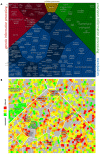A proteomic view of an important human pathogen--towards the quantification of the entire Staphylococcus aureus proteome
- PMID: 19997597
- PMCID: PMC2781549
- DOI: 10.1371/journal.pone.0008176
A proteomic view of an important human pathogen--towards the quantification of the entire Staphylococcus aureus proteome
Abstract
The genome sequence is the "blue-print of life," but proteomics provides the link to the actual physiology of living cells. Because of their low complexity bacteria are excellent model systems to identify the entire protein assembly of a living organism. Here we show that the majority of proteins expressed in growing and non-growing cells of the human pathogen Staphylococcus aureus can be identified and even quantified by a metabolic labeling proteomic approach. S. aureus has been selected as model for this proteomic study, because it poses a major risk to our health care system by combining high pathogenicity with an increasing frequency of multiple antibiotic resistance, thus requiring the development of new anti-staphylococcal therapy strategies. Since such strategies will likely have to target extracellular and surface-exposed virulence factors as well as staphylococcal survival and adaptation capabilities, we decided to combine four subproteomic fractions: cytosolic proteins, membrane-bound proteins, cell surface-associated and extracellular proteins, to comprehensively cover the entire proteome of S. aureus. This quantitative proteomics approach integrating data ranging from gene expression to subcellular localization in growing and non-growing cells is a proof of principle for whole-cell physiological proteomics that can now be extended to address physiological questions in infection-relevant settings. Importantly, with more than 1700 identified proteins (and 1450 quantified proteins) corresponding to a coverage of about three-quarters of the expressed proteins, our model study represents the most comprehensive quantification of a bacterial proteome reported to date. It thus paves the way towards a new level in understanding of cell physiology and pathophysiology of S. aureus and related pathogenic bacteria, opening new avenues for infection-related research on this crucial pathogen.
Conflict of interest statement
Figures








References
-
- Boucher HW, Corey GR. Epidemiology of methicillin-resistant Staphylococcus aureus. Clin Infect Dis. 2008;46:344–9. - PubMed
-
- Wasinger VC, Cordwell SJ, Cerpa-Poljak A, Yan JX, Gooley AA, et al. Progress with gene-product mapping of the Mollicutes: Mycoplasma genitalium. Electrophoresis. 1995;7:1090–4. - PubMed
-
- Cravatt BF, Simon GM, Yates JR., 3rd The biological impact of mass-spectrometry-based proteomics. Nature. 2007;7172:991–1000. - PubMed
Publication types
MeSH terms
Substances
LinkOut - more resources
Full Text Sources
Molecular Biology Databases

